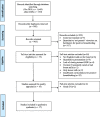Positive breastfeeding experiences and facilitators in mothers of preterm and low birthweight infants: a meta-ethnographic review
- PMID: 34838104
- PMCID: PMC8627052
- DOI: 10.1186/s13006-021-00435-8
Positive breastfeeding experiences and facilitators in mothers of preterm and low birthweight infants: a meta-ethnographic review
Abstract
Background: Most qualitative research on breastfeeding the preterm or low-birthweight (LBW) infant has focused on negative insights; there are no comprehensive insights into how, when and why mothers experience positive breastfeeding experiences. We aimed to address this knowledge gap by exploring what characterizes and facilitates a positive breastfeeding experience in mothers of preterm and/or LBW infants.
Methods: A systematic review using meta-ethnographic methods was conducted. Search strategies involved a comprehensive search strategy on six bibliographic databases, citation tracking and reference checking. The analysis involved a reciprocal level of translation and a line of argument synthesis.
Results: Searches identified 1774 hits and 17 articles from 14 studies were included, representing the views of 697 mothers. A positive breastfeeding experience was identified as being 'attuned'. Three themes and eight sub-themes were developed to describe what characterizes attuned breastfeeding. 'Trusting the body and what it can do', concerned how attuned breastfeeding was facilitated through understanding the bodily responses and capacity and feeling comfortable with holding the infant and to breastfeed. 'Being emotionally present - in the here and now' described the importance of feeling relaxed and reassured. 'Experiencing mutual positive responses', illuminated how attunement was related to feelings of mutuality - when the mother recognises the infant's cues, responds to these signals and receives a positive response from the infant. The key factors to facilitate attuned breastfeeding were opportunities for prolonged close physical contact with the infant, positive relationships with and support from staff and peers, and being facilitated to breastfeed when the infant showed feeding cues.
Conclusions: This study provides new insights into what characterizes a positive breastfeeding experience and how staff can facilitate and enable mothers to achieve attuned breastfeeding. Improvements in units' design, such as for rooming-in and having prolonged skin-to-skin contact, and care provided by knowledgeable, supportive and encouraging staff and peers, are crucial. The mother's physical and emotional states and the infant's behavioural responses and physiological signals should guide the process towards positive breastfeeding practices.
Keywords: Attunement; Breast milk; Breastfeeding; Feeding; Low-birthweight; Mother; NICU; Neonatal; Parent; Preterm.
© 2021. The Author(s).
Conflict of interest statement
The authors declare that they have no competing interests.
Similar articles
-
Avoidance of bottles during the establishment of breastfeeds in preterm infants.Cochrane Database Syst Rev. 2021 Oct 21;10(10):CD005252. doi: 10.1002/14651858.CD005252.pub5. Cochrane Database Syst Rev. 2021. PMID: 34671969 Free PMC article.
-
Breastfeeding experience, barriers, and facilitators among mothers of vulnerable low birth weight infants in Amhara region, Ethiopia: a qualitative exploratory study.Int Breastfeed J. 2025 Jul 1;20(1):51. doi: 10.1186/s13006-025-00731-7. Int Breastfeed J. 2025. PMID: 40597417 Free PMC article.
-
Support for healthy breastfeeding mothers with healthy term babies.Cochrane Database Syst Rev. 2022 Oct 25;10(10):CD001141. doi: 10.1002/14651858.CD001141.pub6. Cochrane Database Syst Rev. 2022. PMID: 36282618 Free PMC article.
-
Optimal duration of exclusive breastfeeding.Cochrane Database Syst Rev. 2002;(1):CD003517. doi: 10.1002/14651858.CD003517. Cochrane Database Syst Rev. 2002. Update in: Cochrane Database Syst Rev. 2012 Aug 15;(8):CD003517. doi: 10.1002/14651858.CD003517.pub2. PMID: 11869667 Updated.
-
Antiretrovirals for reducing the risk of mother-to-child transmission of HIV infection.Cochrane Database Syst Rev. 2007 Jan 24;(1):CD003510. doi: 10.1002/14651858.CD003510.pub2. Cochrane Database Syst Rev. 2007. Update in: Cochrane Database Syst Rev. 2011 Jul 06;(7):CD003510. doi: 10.1002/14651858.CD003510.pub3. PMID: 17253490 Updated.
Cited by
-
Predictors of Human Milk Feeding and Direct Breastfeeding for Infants with Single Ventricle Congenital Heart Disease: Machine Learning Analysis of the National Pediatric Cardiology Quality Improvement Collaborative Registry.J Pediatr. 2023 Oct;261:113562. doi: 10.1016/j.jpeds.2023.113562. Epub 2023 Jun 16. J Pediatr. 2023. PMID: 37329981 Free PMC article.
-
Complications of Preterm Birth-The Importance of Care for the Outcome: A Narrative Review.Medicina (Kaunas). 2024 Jun 20;60(6):1014. doi: 10.3390/medicina60061014. Medicina (Kaunas). 2024. PMID: 38929631 Free PMC article. Review.
-
Patterns of Breastfeeding and Human Milk Feeding in Infants with Single-Ventricle Congenital Heart Disease: A Population Study of the National Pediatric Cardiology Quality Improvement Collaborative Registry.Breastfeed Med. 2023 Apr;18(4):315-325. doi: 10.1089/bfm.2023.0036. Breastfeed Med. 2023. PMID: 37071633 Free PMC article.
-
Twin Challenges in Türkiye: Exclusive Breastfeeding Rates and Predictors of Breastfeeding Duration in a Tertiary Care Center.Children (Basel). 2025 Jun 6;12(6):735. doi: 10.3390/children12060735. Children (Basel). 2025. PMID: 40564693 Free PMC article.
-
"Breastfeeding at Night Is Awesome" Mothers' Intentions of Continuation of Breastfeeding Extreme and Very Preterm Babies upon Discharge from a Kangaroo Mother Care Unit of a Tertiary Hospital in South Africa.Healthcare (Basel). 2023 Apr 6;11(7):1048. doi: 10.3390/healthcare11071048. Healthcare (Basel). 2023. PMID: 37046975 Free PMC article.
References
-
- Bonet M, Blondel B, Agostino R, Combier E, Maier RF, Cuttini M, Khoshnood B, Zeitlin J, MOSAIC research group Variations in breastfeeding rates for very preterm infants between regions and neonatal units in Europe: results from the MOSAIC cohort. Arch Dis Child Fetal Neonatal Ed. 2011;96(6):450–452. doi: 10.1136/adc.2009.179564. - DOI - PubMed
-
- Wilson E, Edstedt Bonamy AK, Bonet M, Toome L, Rodrigues C, Howell EA, Cuttini M, Zeitlin J, the EPICE Research Group Room for improvement in breast milk feeding after very preterm birth in Europe: results from the EPICE cohort. Matern Child Nutr. 2018;14(1):e12485. doi: 10.1111/mcn.12485. - DOI - PMC - PubMed
Publication types
MeSH terms
LinkOut - more resources
Full Text Sources
Medical
Miscellaneous


